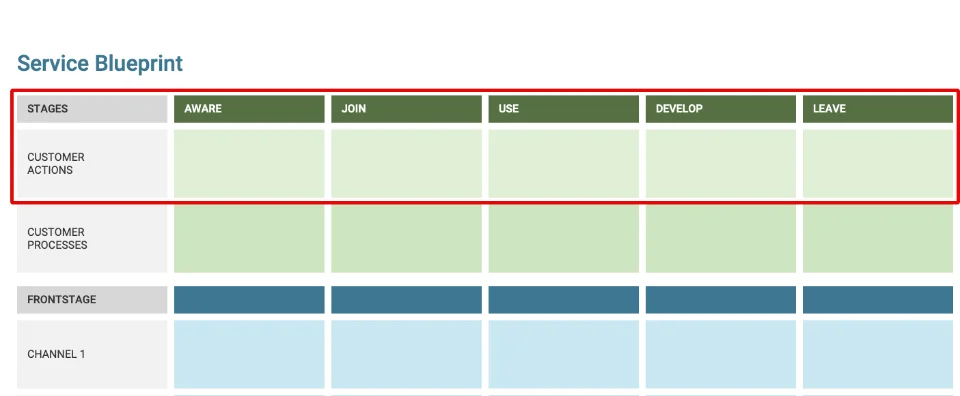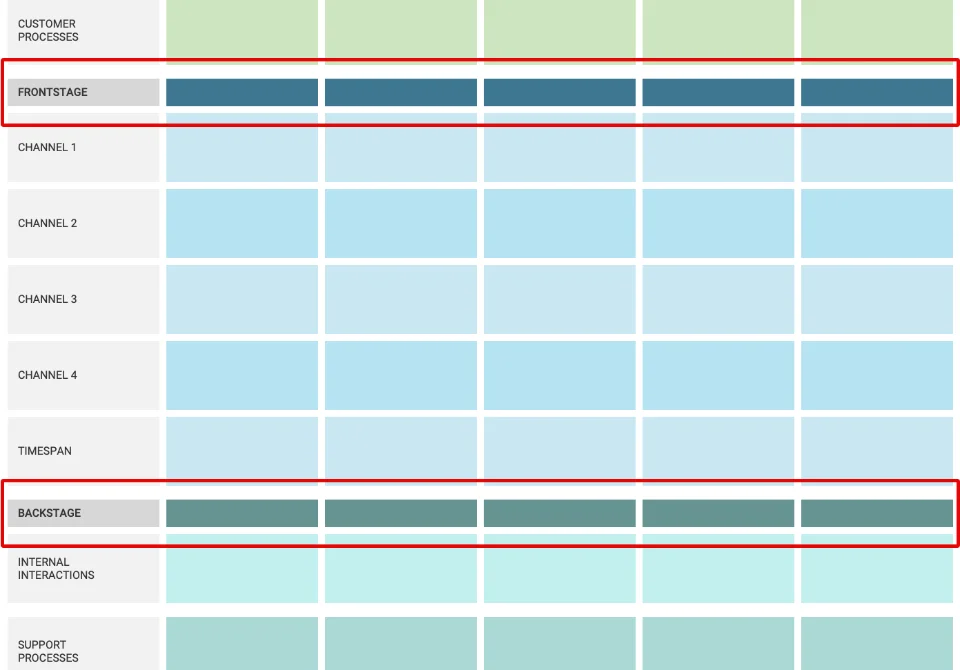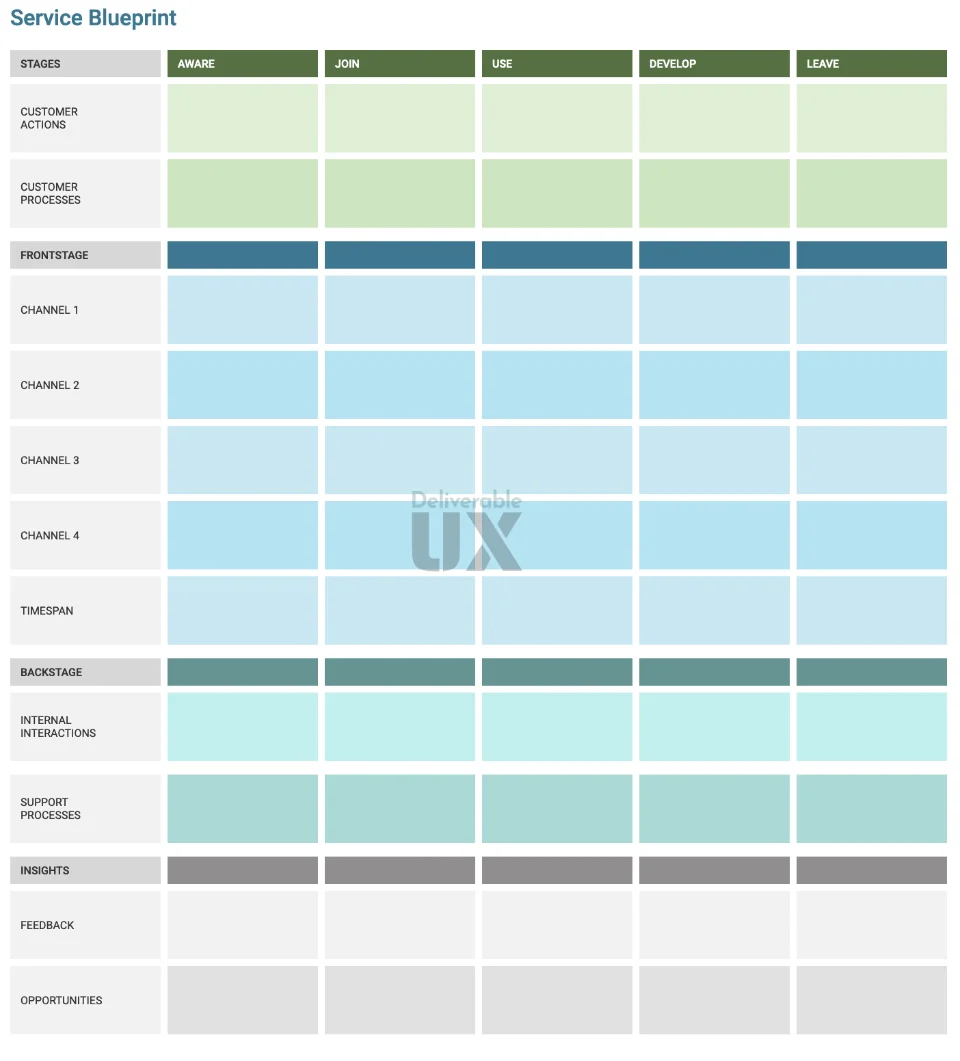What are the Stages of a Service Blueprint?
A good place to start with the user journey through the service are with the 5 stages of Aware, Join, Use, Develop, and Leave. Remember though, in general there are no set stages for a service blueprint, merely the phases the journey journey. The above 5 stages are merely guides that we like starting with to remind us of important aspects. You may want to adjust based on your particular project or service.
Wes Hunt

Stages in a service blueprint are used in multiple ways, however what most refer to when thinking of the stages of a service blueprint are the phases of the customer journey. There are also the stage metaphors, the visibility of the service reactions, the Frontstage and Backstage actions. These are separated by the lines of interaction and visibility between the customer and the service. We will cover both, and multiple ways to think about the customer actions stages of a service. To learn more about other aspects of a service blueprint, like the components, read What Are the Components of a Service Blueprint?
Stages of a Service Blueprint
The stages of a service blueprint are the phases of the customer journey when experiencing the service. Furthermore, a great way to describe the journey is in 5 stages: Aware, Join, Use, Develop, and Leave. From “Service Design” by Andy Polaine; Ben Reason; Lavrans Løvlie. We like using these as a good place to start and adjust based on the specific service scope. Remember though, these and any other stages you encounter should only be used as a guide. It is better to properly represent the customer phases with the specific service than to strictly follow a template. The stages can represent either an entire customer lifecycle or a single session with the service.
Aware Stage
The Aware Stage is the first stage of the customer journey in a service blueprint. This is the point when the user first becomes aware of the service. They may learn about it through advertising, word of mouth, or by simply stumbling across it. At this stage, they are not yet customers, but they have the potential to become one. The goal of the Aware Stage is to pique the user's interest and persuade them to learn more about the service. To do this, businesses need to create an engaging and informative online presence. This may include a website, social media accounts, and online ads. By providing useful and interesting information, businesses can attract users to their service and convince them to take the next step.
Remember, as with all phases, there could be multiple actions and touchpoints in a single stage. Actions can also be cyclical.
Examples of the Aware Stage
- Finds a class brochure for the local community college at their local library, then calls and talks to a student representative. They may talk to a friend who attends the college.
- Reads about data visualization tools offered by the service on Facebook because of their interest in the topic. They then watch a tutorial on Youtube about using the visualization tools.
- A nurse talks to marketing representatives at a booth during a health conference, signs up for a webinar, then attends the webinar.
- Sees Agile PM training in a list of ads next to search results for a related search multiple times over the course of months, when they become more serious about training later they do more research and read an article on the Agile coaching website. They save calendar dates with the services Agile training schedule.
Importance of the Aware Stage
This may or may not be obvious but raising awareness of a service is critical to its success. Whether the service is a business, a community offering, or a government outreach program. With every stage it is important to be very realistic about the customer journey. Are they even aware of the problem the service is solving? This is critical, does the organization need to educate the market before people are even interested in a solution?
Join Stage
The user decides to join the service through registration or some other form of communication. Knowing the rate of drop-off here is good to know and is one of the easiest phases to have meaningful analytics around. Important questions here is how easy is it for the customer to join the service? Do you need to require a registration process for a trial or can you put it later in the phase? How many challenges are in place for a person becoming a user of the service? Some challenges maybe necessary, but the Join Stage is where you want to highlight all of them and determine if they can be moved or removed.
Examples of the Join Stage
- A potential customer adds outdoor gear to an online shopping cart, then abandons the cart, comes back in 3 days and sees the gear sitting in the shopping cart and initiates the checkout steps. After purchase they have an opportunity to create an account.
- A potential customer tries to add gear to a shopping cart, but has to signup before they can add. 20% of customers signup and complete the purchase process; 80% abandon the attempt.
Importance of the Join Stage
At this point a still potential customer decided to join your service. You need to ensure this process is as streamlined as possible. However, this is not as straightforward as many believe. Requiring registration up front may allow the service to focus on the more motivated customers, or be necessary to improve the overall experience. For example, providing first step emails to start educating customers on the service.
Use Stage
The Use Stage is where product teams live and usually concentrate on, this is the entire period that a person is “using” the service. It can be short or long term, cyclical or linear. Again, because this is part of service design, we may be including multiple products, teams, and interfaces or physical activities. Think about how someone may use service kiosks at the Smithsonian. This phase could show all of the activities users are doing in a service. I like to include activities that may be happening outside of the service too. This can be done for any stage, but if people are using multiple services to address problems that your service supposedly solve, then there’s room for improvement.
Examples of the Use Stage
- ED nurses use the mobile app during patient intake. They update details about the patient on a desktop computer when the patient moves to another department. At the end of the month they see a roll-up report that is automatically emailed to them about all ED patients.
- An investor uses an accounting web application to track stock trades throughout the year, Google Sheets to track their crypto portfolio (accounting service doesn’t handle crypto). At the end of the year they need to tally up their profits, losses, and wash sales. They then use another service for taxes, and a third party tax software for crypto that imports into their main tax software.
- A customer visits REI 1/month to buy supplies for skiing, biking, and camping. They use the repair shop at REI 1/winter to wax and repair their skis, 1/summer to tune their bike. After an email about store activities in the Aware stage, they attend a webinar on REI.com about gear maintenance. The gear maintenance webinar raises awareness about REI’s used gear program and the customer trades in some ski boots.
Importance of the Use Stage
Probably self-explanatory, however you can see companies everywhere that forget about the customer’s repeat usage once they get paid. What is the overall user experience like while using the service(s)? Are they using features of the service in unexpected ways? It is good to see where the touchpoints are here, if it is through a specific device type for a digital service or a set of locations. What is the statistics around user context during usage? If 20% of usage is during remote work, or a commute that could be important.
Develop Stage
This is one of the phases that I appreciate the most to use as a guide. Many would describe the usage phase into the leaving or post usage phase. The Develop Stage describes how a user expands their usage of the service. Are they increasing usage, starting to use multiple products from the service? By calling this phase out you bring focus to an area of business that can bring the most success for a business (retention/expansion is cheaper than new sales) and is a big indicator of customer happiness. If a customer isn’t expanding their usage then they either are indifferent about their experience or are displeased and minimize their interaction with the service.
Examples of the Develop Stage
- A customer forum where current customers can find community support or mentor other users of the system.
- Web conference for power users to give feedback on new features.
- Industry education resources that may or not directly use an existing product.
- Offering discounts or exclusive services for existing students in a training program.
Importance of the Develop Stage
This could also be the “drop the ball” stage, Companies and other organizations often fall short in the Develop Stage. For example they sell a complicated piece of equipment, but don’t help the customer learn how to use it or fully utilize it. If a customer doesn’t fully utilize a product or multiple offerings of a service, will they renew their membership to the service later? Many purchases are aspirational for new customers, especially training. Knowing how or if new students are using your service is important for repeat customers. In government, there are many services that get under utilized by constituents.
Leave Stage
When the customer stops using the service. This may be an intended phase of the service or represent customer churn that is unwanted. Based on the scope of the service blueprint, this stage could also represent transitioning the customer to another service.
Examples of the Leave Stage
- Delivery of groceries from an order.
- Resident was placed in permanent housing after working with public housing department.
- Customer canceled their streaming subscription.
- Customer of a bank closes on a house after going through the bank’s mortgage service.
Importance of the Leave Stage
The Leave Stage has a lot of opportunities to renew or maintain relationships with customers/users of a system. This is also where the service designer can research why customers drop off here or if some other goal isn’t being met. The Leave Stage doesn’t represent failure most of the time, it just represents the final stage of a customer journey. As in the example of a mortgage or public housing, success is getting a customer to the Leave Stage and in a house.
Stages as a Metaphor

So stages are also used as a metaphor for what happens visibly (Frontstage) and invisibly (Backstage) in relation to the customer, as with a theater stage. In theater, the patrons see the actors performing on the stage, but they do not always see all the effort and number of people working behind the scenes. The same is true for a service, what the customer sees is only the tip of the iceberg!
Frontstage Actions
These are touchpoints and actions that are visible to the customer. These are both the customer actions and touchpoints with the service, but also reactions or interactions from the company around the service. There may be employees who work with or talk to the customer, emails sent, or a website the customer visits.
Examples of Frontstage Actions
- Automated email sent to customers when they signup, or purchase a product.
- The barista taking an order, making a coffee, and serving the customer.
- The mobile application to order a coffee before entering the coffee shop.
Backstage Actions
These are actions that are not visible to the customer. What is going on “behind the curtain” in response to touchpoints with the customer? In some interactions this could very well be the largest amount of activity. I really like to dig into these supporting actions, because there’s often opportunities to optimize actions here. It can also highlight the amount of work that happens behind the scenes for parts of the team.
Examples of Backstage Actions
- A DBA (database administrator) runs a report each month of customer utilization.
- A CRM system like SugarCRM updates a customer’s status when they make a new purchase.
- An email system sends an account registration confirmation email immediately, a next steps email after a day, and schedules a reminder email in a month.
Summary
A good place to start with the user journey through the service are with the 5 stages of Aware, Join, Use, Develop, and Leave. Remember though, in general there are no set stages for a service blueprint, merely the phases the journey journey. The above 5 stages are merely guides that we like starting with to remind us of important aspects. You may want to adjust based on your particular project or service.
